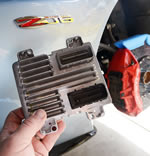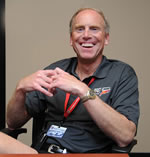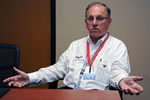Ruthless Pursuit of Power: The Mystique of the C6 Corvette LS7 Engine - Page 16 of 26
Ruthless Pursuit of Power: Lucky Seven Edition: The Mystique of the 7-Liter, 7000-RPM, LS7 - Page 16 of 26
 |
 |
by Hib Halverson
© May 2013— Updated: November 2014
No use without permission, All Rights Reserved
The LS7 debuted in 2006 with the GM E38 engine controller which uses a Freescale Power PC chip as its main microprocessor. Interestingly, the Power PC "Reduced Instruction Set Computer " (RISC) chip was originally developed in 1991 by an alliance of Apple, IBM and Motorola (now Freescale) for Macintosh personal computers. Today, Freescale PPC chips are common in all kinds of automotive engine control, chassis control, body control and telematics applications.
There are four slightly different versions of the LS7's E38. The first was used in '06 and '07, the second in '08, the third in '09 and '10 and the final variation for '11-'13. All these different versions increased processor speed, enhanced memory maps and eventually added a second micro processor. The 2008 version had 32-bit processor with a floating point unit (FPU) which runs at 40-MHz and has 2 Mb of external flash ROM and 64Kb of RAM.
The Final Push
As the LS7 development closed on deadlines forced by GM's intent to debut the engine in the 2006 Z06, the engine's power output had plateaued somewhat below the 500-hp goal set by that pesky senior management.
"For a while it looked like 480 was going to be the number," Corvette Chief, Tadge Juechter recalled in a Spring 2012 interview with the CAC, "but then, they pulled the rabbit out of the hat at the end. This was on the eve of production! I'm talking about the end of '04. We're already ordering material to build our nonsaleable validation vehicles at the plant so, we're holding up the presses at that point, trying to decide--'Ok, guys, what is the horsepower?' and remember, it was, also, the first engine in the auto industry certified to (the then-new) SAE standard. That was another level of rigor that we had to go though. The very last part released for production was the Z06 badge which said '505-hp'. In fact, we were thinking we'd have to go to production without any number on there because we didn't know what it was going to be."
"There were challenges," Nichols continued. "We had a port that was pretty big. We still had to do all the right mixing to be able to measure pre-converter oxygen. We had to fit them to a catalytic converter that didn't have a lot of packaging space to move in. They came up with a design which could work, but it was not cheap. It's a significant ingredient of the cost of that engine. The carrot was, a significant improvement in flow and restriction. Those manifolds ended up being worth about nine horsepower."
The second, even more complicated change, put the LS7 "over the top" and was a late modification to the LS7's cylinder case. As we said in the first part of this article, early in the development program, unlike its predecessor LS6, the LS7 block had no main web windows for bay-to-bay breathing. The CAC's discussions with former LS7 boss (and current Chief Engineer for V6 engines), Dave Muscaro, revealed how his team found about another 10-hp by developing block windows which did not compromise strength. "We were pushing 490-495hp for about the last 6 months of development," Muscaro told us. "The one area we knew still had promise was in our bottom-end breathing. If we could improve bay-to-bay breathing, we could reduce the work required by the bottom side of the pistons to move air around. The Corvette is extremely challenging in this area due to the engine's low position in the car. The ground clearance requirements disallow ample room in the oil pan to aid in lower end breathing which puts additional challenges on finding ways to reduce the (power loss in) lower end pumping work.
"So (while other parts of LS7 development moved ahead) we continued to look for ways to improve breathing by way of the engine block itself. The LS6 utilized openings in the main bearing webs to help its bottom end breathing but, up to this point, we had not been able to identify similar LS7 engine block changes that could withstand the additional loads put on it by the power levels being achieved. After numerous design iterations run through structural analysis computer modeling, we came up with engine block design revisions (one was the change in hone over-travel radii discussed earlier) that incorporated bay-to-bay breathing portals--known as 'hone over-travel windows'--that met all structural durability requirements.
"That final look in this area", Muscaro continued, "gave us a design which met the structural requirements and one which we knew would also improve our lower end breathing and therefore increase the engine's power output. Blocks were ordered to this design revision and we began testing them. In those tests, as predicted, we saw an immediate improvement in our bottom end breathing as demonstrated by the engine's power level increase of 10-15 hp. We proved the revision's durability and made the new block part of our production package."
 |
 |





